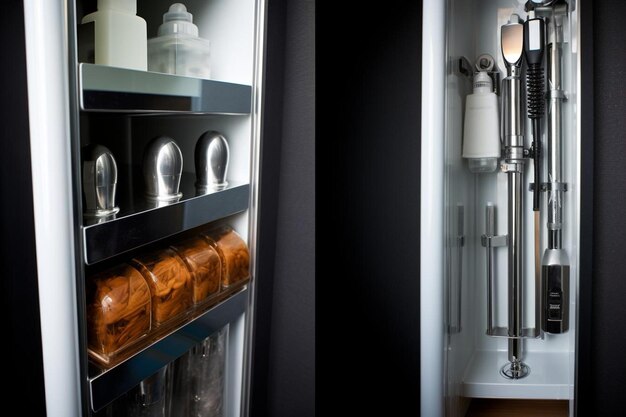Understanding the Size and Capacity of a 4.5 Cubic Foot Refrigerator
When it comes to compact kitchen appliances, a 4.5 cubic foot refrigerator often stands out as a versatile choice for many households. Whether you're optimizing space in a small apartment, enhancing your college dorm room, or creating a convenient office kitchenette, understanding the dimensions of this type of refrigerator can greatly aid in your decision-making process. Let's dive into what you need to know about this compact yet efficient refrigeration option!
🧊 Why Choose a 4.5 Cubic Foot Refrigerator?
Before exploring the specific measurements, let's address why a 4.5 cubic foot refrigerator might be ideal for your needs. Compact refrigerators are designed to offer efficient use in limited spaces without compromising essential features. Here are some key benefits:
- Space-Saving: Perfect for small kitchens, dorms, and office spaces.
- Energy Efficiency: Typically consumes less power than larger models.
- Affordability: Generally less expensive than full-sized alternatives.
📏 What Are the Typical Dimensions?
A refrigerator’s cubic foot size refers to its internal capacity. However, physical dimensions will determine if it fits your space. While dimensions can vary by brand and model, a 4.5 cubic foot refrigerator generally comes with these approximations:
- Height: Ranges from 32 to 35 inches.
- Width: Typically around 20 to 24 inches.
- Depth: Generally spans 20 to 24 inches.
Understanding these general ranges helps ensure your refrigerator will fit within the space you have allocated. Still, always confirm specific measurements from the manufacturer.
📐 How to Measure for a Refrigerator
For the best fit, knowing how to accurately measure your available space is crucial. Follow these steps:
Measure Your Space: Use a tape measure to determine the height, width, and depth of the space where you plan to place the refrigerator. Ensure you measure from wall to wall for precision.
Consider Door Clearance: Account for the space required to fully open the refrigerator door—this includes clearance from walls or adjacent cabinets.
Allow for Ventilation: Leave a few inches at the back, sides, and top of the unit for proper air circulation to prevent overheating and ensure efficiency.
🛠️ Installation and Placement Tips
Once you know your refrigerator will fit, here are some essential setup tips:
- Leveling: Ensure the floor is level. Most models have adjustable legs to cater to minor slant adjustments.
- Accessibility: Ensure the unit is easily accessible and placed where the door can open without obstruction.
- Proximity to Outlets: Ideally, place it near a power outlet to avoid long extension cords, which are not recommended for high-power appliances.
🌟 Ideal Uses for a 4.5 Cubic Foot Refrigerator
Many find compact refrigerators useful across diverse settings. Here are some worthy considerations:
Dorm Room Essential
In college, space can be a luxury. A compact refrigerator offers enough space for snacks, beverages, and leftovers while fitting comfortably under a desk or in a closet.
Office Kitchenette
Perfect for a small office, this refrigerator can store lunch items and office treats, making it a conducive option for break rooms.
Supplemental Home Unit
This refrigerator can serve as a secondary unit in home bars or game rooms, offering convenience without taking up much space.
🚦 Things to Consider Before Buying
Energy Use
Most compact refrigerators are energy-efficient, but looking for the ENERGY STAR label can further ensure you save on utility bills.
Features
Determine if additional features fit your needs, such as adjustable shelves, a freezer compartment, or can dispensers.
Material and Style
Choose a refrigerator finish that complements your space, whether it's sleek stainless steel, matte black, or white.
Reliability
Research customer reviews on the reliability and performance of specific models to ensure you are getting a durable product.
🔍 Exploring Related Subtopics
Understanding refrigerator dimensions adds context to the broader topic of size and capacity in appliances. Let's delve into connected considerations:
Capacity vs. Physical Size
While cubic footage indicates capacity, it's essential to differentiate it from the tangible exterior sizes that affect space use. The two can sometimes be confusing but serve distinct roles in a purchase decision.
Maintenance Requirements
Knowing how to maintain a compact refrigerator extends its lifespan. Regular cleaning, defrosting the freezer, and ensuring the door seals are in good condition are all part of routine care.
The Role of Location
Where you place your refrigerator impacts its efficiency and convenience. Avoid direct sunlight and moisture-prone areas to ensure optimal performance.
📝 Quick Tips for Buying a 4.5 Cubic Foot Refrigerator
Here is a handy checklist to guide you through your refrigerator purchase:
- ✅ Measure Twice: Accurately check your intended placement area and ensure door clearance.
- ✅ Check Energy Efficiency: Look for appliances with the ENERGY STAR rating for better savings.
- ✅ Match Your Style: Choose a unit that complements your existing decor and appliance style.
- ✅ Feature Prioritization: Decide which features, like door design or internal configuration, are essential.
- ✅ Research Reliability: Look into consumer reviews for insight into brand and model reliability.
🌈 Bringing It All Together
Understanding the dimensions, capabilities, and potential uses of a 4.5 cubic foot refrigerator creates a solid foundation for selecting the perfect model for your space. These compact units embody efficiency and convenience, meeting the needs of various living and working environments. Whether you’re outfitting a college dorm room or adding comfort to a small office space, the right refrigerator can make all the difference in food storage and accessibility. Take time to explore your options, consider your needs, and make a choice that complements your lifestyle seamlessly.
